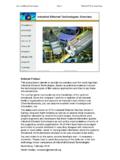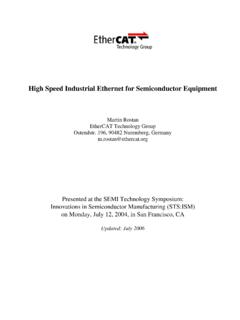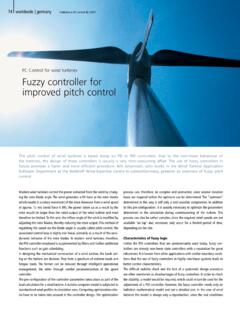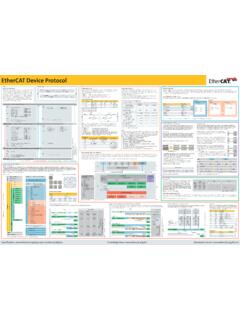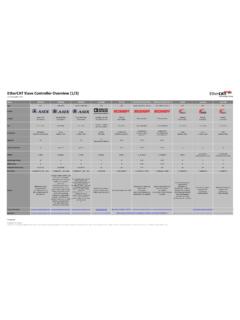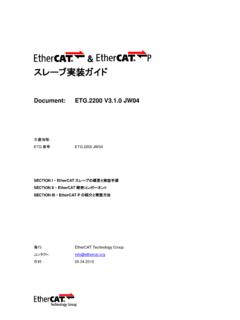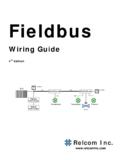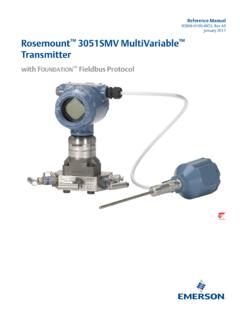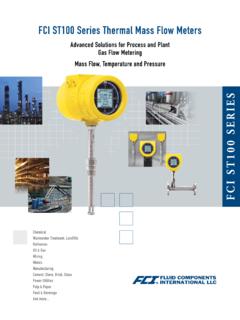Transcription of EtherCAT - the Ethernet fieldbus
1 At the field level, the fieldbusses developed in the 90s continue to dominate themarkets. Fieldbusses have created their respective market segments focussing ondifferent aspects, and with maximum gross transfer rates of 16 MBaud theycontinue to be quite adequate for many applications. However, due to the verylow quantities of components sold compared with the general IT world, overallcosts are rather high both for the control and for the field devices, and partic-ularly for the wiring. The required flexibility with regard to signal granularity wasand is achieved through modular field devices that operate a subordinate sub-bus. Such sub-bus increases the complexity of the overall system and has signif-icant performance disadvantages with regard to dead time and achievable EtherCAT ?While Moore s Law (doubling of performance approximately every 2 years) hasremained valid over recent years, and will continue to apply in future, for PC-based control systems, no significant further development has occurred for field-busses.
2 Instead, the majority of fieldbus organizations and large automationcompanies chose Ethernet as the future extension or replacement for propri-etary fieldbus technology, and associated standards were this background, a company such as Beckhoff can expect to be asked: Why yet another Ethernet approach? The short, but concise answer is: Ether-CAT takes a different route and is currently by far the most powerful Ethernet ap-proach, and the one that is best tailored to automation requirements! A sound,technically substantiated response is presented in this at the I/O level is not without problemsCompared with existing fieldbusses, Ethernet has not only advantages. Ethernetfeatures which make it less suitable for automation technology applicationsshould therefore be considered very carefully and circumvented wherever possi-ble. The main differences between the different approaches for adapting Ethernetto automation technology can be found in these Ethernet features:|High overhead for communication with devices that have to exchange smallquantities of data frequently.
3 |High connection costs per device compared with classic fieldbus nodes (trans-former, PHY, MAC and required processor performance).|Lack of real-time capability which, on closer inspection, is caused by slow runtimes in the software stacks, rather than by the fact that Ethernet is used asthe transmission medium.|Unfavorable topology. Ethernet now commonly uses a star topology,although this is rather unfavorable when it comes to system wiring and canlead to excessive cabling effort or highly cascaded communication factor is that not all Ethernet installations are identical. Apart from dif-ferent transmission speeds of 10, 100 or 1000 MBaud, a distinction has to bemade between half and full duplex communication. Compared with full duplex,half duplex data transfer that alternates between two directions transfersless than half the amount of data, since the system has to pause after each trans-fer in one direction to compensate for propagation and response times.
4 Half du-plex transfers can cause collisions which, while they are intercepted at the lowerlevels and corrected through repetitions, are not acceptable for deterministictransfers. Collisions therefore have to be avoided at higher levels, yet this in turnis not possible without further deterioration of the usable data for the development of EtherCATDue to the performance capabilities of the PC system, PC-based control technol-ogy can support a more central or more precisely a hierarchical control phi-losophy, whereby all the pieces of information that are relevant at a particularAutomation technology worldwide increasingly uses Ethernet as the physical communication layer. Ethernet has already be-come established at the command level, for factory networking and for inter-control communication. Due to the high component quantities usedin office environments, it is comparatively powerful and the Ethernet fieldbusThe technical response to the question: Why EtherCAT ?
5 And/or memory areas. The EtherCAT commands are transported in the data areaof an Ethernet telegram and can either be coded via a special Ether type or telegram structure (with and without UDP)While the first variant with special Ether-type is limited to an Ethernet subnet, telegrams are not relayed by the routers, for control tasks this usual-ly does not represent a constraint. The Ethernet MAC address of the first deviceis used for addressing. This requires a special first EtherCAT device, although thisis not necessary for direct communication without second variant via UDP/IP generates a slightly larger overhead (IP and UDPheader), but for less time-critical applications it enables normal IP routing to beused. On the master side, the frequently already existing TCP/IP stacks can beused. Each EtherCAT command consists of an EtherCAT header, the data area anda subsequent counter area (working counter), which is incremented by all Ether-CAT devices that were addressed by the EtherCAT command and have exchangedassociated Memory Management Unit (FMMU)Using the telegram structure described above, several EtherCAT devices can beaddressed via a single Ethernet telegram with several EtherCAT commands, whichleads to a significant improvement of the usable data rate.
6 However, for 2 bit in-put terminals with precisely 2 bit of user data, the overhead of a single EtherCATcommand is still fieldbus Memory Management Unit eliminates this problem and the avail-able data rate to be utilized is almost 100 percent even for devices with only 2bits of user data, as described. Similar to the Memory Management Units (MMU)in modern processors, the FMMU converts a logical address into a physical onevia an internal table. The FMMU is integrated in the EtherCAT slave ASIC and en-ables individual address mapping for each contrast to processor-internal MMUs that map complete memory pages (in therange of 4 kB), the FMMU also supports bit-wise mapping. This enables the twobits of the input terminal to be inserted individually anywhere within a logical ad-dress space. If an EtherCAT command is sent that reads or writes to a certainmemory area, instead of addressing a particular EtherCAT device, the 2 bit inputterminal inserts its data at the right place within the data area.
7 All other termi-nals that also detect an address match within their own FMMU also insert theirdata, so that many devices can be addressed simultaneously with a single Ether-CAT are known simultaneously in a control system and can be combined witheach other. This not only makes system configuration easier, but also enables theuse of more intelligent control algorithms. In this configuration, the communica-tion system is only responsible for the fast transport of the process data to andfrom the control. A master/slave communication system is the best choice for thispurpose. The development of EtherCAT mainly focused on the following targets:|Broad applicability. Any control with a commercially available Ethernet con-troller should be able to be used as an EtherCAT master. Starting with small16 bit processors to PC systems with 3 GHz processors, any computer shouldbe able to turn into an EtherCAT control system without special connections.|Full conformity with the Ethernet standard.
8 EtherCAT should be able to co-exist with other Ethernet devices and protocols on the same bus. Standardstructural components such as Ethernet switches should be usable for Ether-CAT.|Smallest possible device granularity without subordinate sub-bus. More com-plex nodes or 2 bit I/Os should be able to be used economically as EtherCATslaves.|Maximum efficiency. As much of the Ethernet bandwidth as possible shouldbe available for user data transfers.|Short cycle times. Possible cycle times of significantly less than 100 s shouldopen up new areas of application, such as closing of lower drive technologycontrol loops.|Maximum deterministic properties, even without the basis of absolutetelegram transfer operating principleFrom an Ethernet point of view, an EtherCAT bus is simply a single large Ethernetdevice. This device receives and sends Ethernet , the device does not contain an Ethernet controller with downstreammicroprocessor, but a large number of EtherCAT slaves.
9 These process the incom-ing telegrams directly and extract the relevant user data, or they insert them andtransfer the telegram to the next EtherCAT slave. The last EtherCAT slave sendsthe fully processed telegram back, so that it is returned by the first slave to thecontrol as a kind of response telegram. This procedure utilizes the fact that Ethernet deals separately with transfers in separate directions (Tx and Rx lines)and operates in full duplex mode: the transmitted telegrams are returned to thecontrol by loop-back through the Rx wire pair. Naturally, like for any other Ether-net device, direct communication without switch may be established using a crossover Ethernet cable, thereby creating a pure EtherCAT processingTelegrams are processed directly on the fly . While the telegrams (delayed byonly a few bits) are already passed on, the slave recognizes relevant commandsand executes them accordingly. Processing is done within the hardware and istherefore independent of the response times of any microprocessors that may beconnected.
10 Each device has an addressable memory of 64 kB that can be read orwritten, either consecutively or simultaneously. Several EtherCAT commands canbe embedded within an Ethernet telegram, each addressing individual devices10 + m + 2410 + n + 214 ByteEthernetHeader2 EtherCATH eader10 + n + 2 EtherCAT CommandHeader + Data + WC10 + m + 2 EtherCATC ommand4 EthernetCRC14 Byte20 ByteIP Header8 UDP Header2 Transmission layerCableMax. lengthCosts AssemblyDelay(connection/meter)character istics (per connection in s) Ethernet (100 Base TX)CAT 5 100 mo / ++ (+1)+approx. 1(copper) Ethernet (100 Base FX)Fiber optic100 km- / ---approx. 1(fiber glass)E-bus (copper)CAT 5 10 m++ / ++ (+1)+ 0(copper)E-bus (fiber optic,Fiber optic100 m+ / +++0in preparation)(plastic fiber)Characteristics of the different physical layers(1industrial cable type i. e. suitable for drag chain applications, oil-resistant)3 Since the FMMU is present in each device and is configured individually, the mas-ter can already assemble complete process images during the initialization phaseand subsequently exchange them via a single EtherCAT command.
